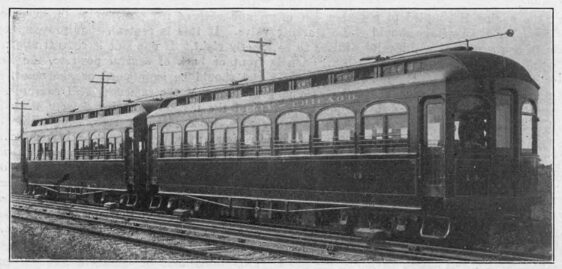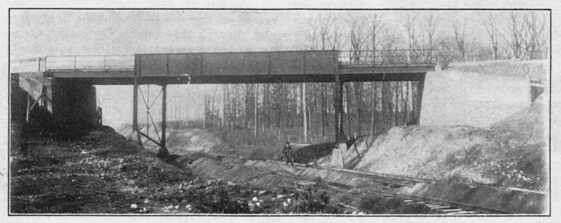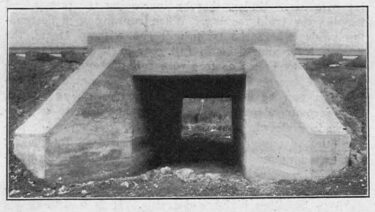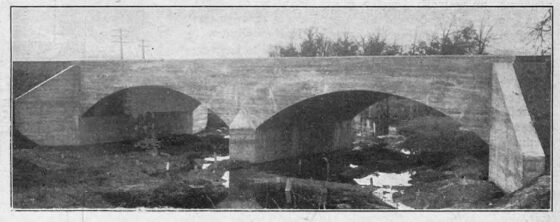[Trade Journal]
Publication: Railroad Gazette
New York, NY, United States
vol. 34, no. 39, p. 736-737, col. 1-2
The Aurora, Elgin & Chicago Interurban Railway.
A good example of the numerous interurban electric roads that have been developed in the Middle West has recently been opened to service from Chicago westward through one of the most populous districts contiguous to that city. It is estimated that the district which this road, the Aurora, Elgin & Chicago, will serve either directly, or by connection with other interurban electric lines, has a population of 150,000. A map of the road showing the towns on the line, together with other electric and steam railroads occupying the same territory is presented herewith.
As will be seen from the map, the eastern terminus of the road is at Fifty-second, avenue, Chicago, where connection is made with the Metropolitan West Side Elevated Railroad (Garfield Park Branch), by which passengers are carried to the heart of the business district in 26 minutes. There are, or will be, three western termini, Aurora, Batavia and Elgin, the first and last of which are cities of 30,000 population. From Fifty-second avenue to the Chicago Golf Club, west of Wheaton, the road is double tracked , a distance of 21 miles. At Wheaton the line branches, one branch running north-west to Elgin, 16½ miles, and the other southwest to Aurora, 14½ miles, with a branch at Eola Junction running northwest to Batavia, 7½ miles. The total mile-age of the line is 82 miles of single track counting sidings, of which there are seven. Two of these are 12 and 1 mile long respectively, and the others are from 800 to 1,500 ft. The Elgin branch, which the map shows as being under construction, will probably be completed by December.
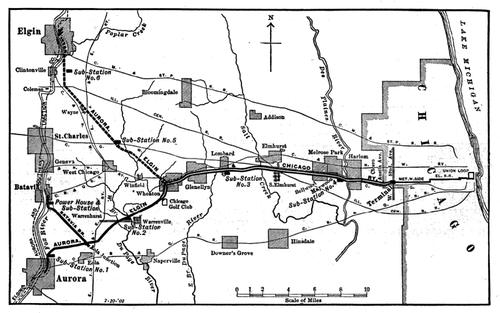 |
| Map of the Aurora, Elgin & Chicago Railway. |
As the road was designed for high speed service the track and bridges are of the most substantial character and the curves and grades were laid out with careful consideration to the character of the service. The company owns its right of way, which for the most partis 100 ft. wide through this country, there being a few short stretches where this is reduced to 66 ft. The ownership of right of way also includes that in the towns, the only parts not belonging to the company being the street crossings and a half-mile of street in Aurora. The right of way is fenced, American Steel & Wire woven wire fencing being used, and every crossing is protected with Climax cattle guards. A third-rail system is used throughout, with the exception of the half-mile of city street in Aurora, where it is necessary to use a trolley.
The physical conditions which the engineers had in mind in designing the road have been referred to. The endeavor was to make the line as nearly straight and level as possible, and how nearly this object was accomplished is indicated by the fact that there are but two points on the line where the grades exceed 1 per cent., these being a 1.8 per cent. grade on the Batavia branch, where the line drops down to the power station, and a 1.2 grade on the Aurora branch. West of the Des Plaines River there are no curves exceeding 2 deg., and these are struck with long radii. East of the river conditions necessitated some sharp curving, the maximum of these being 6 deg. The line is gravel ballasted mostly, rock ballast being used at points where there are deep cuts or where there might be a tendency for the gravel to wash away. The substantial character of the bridges is shown by the engravings. All spans of less than 60 ft. are built of concrete and steel, a gravel filling 12 in. deep being placed over the arch to preserve the flexibility of the roadway. The double-span concrete masonry bridge shown in the illustration has 35-ft. arches. It is interesting to note in this connection that a steam rail-road bridge at this same point, a view of which is obscured by the concrete bridge, is a timber trestle, making more noticeable the character of structure used by the electric road. Another view shows the concrete cattle passes put in for the accommodation of farmers and to avoid the risk of killing stock by the fast trains.
For the longer spans heavy steel plate-girder bridges are used. The longest of these is over the Des Plaines River, there being two 100-ft. double-track through spans. The west branch of the Du Page River has an 89-ft. through-girder span in conjunction with a 22-ft. deck span. Other spans are deck or through-girder, as conditions require, including the overhead highway crossings. Where the Chicago & North Western is crossed by the Elgin branch a 150-ft. through-truss bridge is used. The abutments and piers for all of the bridges are concrete.
| |||
| Two-Car Train — Aurora, Elgin & Chicago Railway. |
The track is laid with 80-lb. rails, 60 ft. long, the standard ties used being 6 x 8 in. by 8 ft., while every fifth tie is 6 x 8 in. by 9 ft., the insulators for the third rail being placed on this extension. The third rail weighs 100-lbs. to the yard and is of a special composition for purposes of conductivity, having 0.10 per cent. of carbon. he insulators have a malleable-iron base, above which is a collar of "Dirigo" insulation surmounted by a malleable cap, on which the rail rests. At crossings the third rail is broken, connection across the break being made by cables laid underground.
The terminal arrangement at Fifty-second avenue to connect with the Metropolitan road was described in our issue of July 25, page 585, in connection with a description of the project whereby the Metropolitan Company moved bodily the incline structure 1,018 ft. long connecting its elevated tracks with the surface. It is the intention to build stations in all of the towns along the route, the nature and extent of these being a matter that will be settled later.
| |||
| An Overhead Highway Crossing-Aurora, Elgin & Chicago. |
The main power station is at Batavia, on the Fox River. The building is 202 ft. 4 in. x 160 ft. 6 in., and is built of Illinois buff brick with white stone foundations and trimmings. There are a number of noteworthy features about this station, of which brief mention will be made. The first of these is the coal and ash handling facilities. Outside of the building, parallel to its long dimension, are two coal tracks, under cover, beneath which are the coal bunkers into which coal may be dumped from the cars. Under the bunkers and boiler room is a basement in which are small cars running on track, into which coal from the bunkers may be discharged. Provision is made for elevating these small cars with their loads to a longitudinal track above the boilers from which the coal is dumped into overhead bunkers which feed to the boilers. These same cars may also be loaded with the ashes from the boilers and hoisted to an overhead hopper, which latter discharges into freight cars.
The boiler battery will comprise ten 500 h.p. units, five of which have been installed. They are water-tube boilers having 4,500 sq. ft. of heating surface, and 500sq. ft. of superheating surface, and were built by the Edge Moor Iron Co., Edge Moor, Del. The front of each boiler is a Kinnear steel rolling door, a novel feature, made necessary by the overhead arrangement of chutes. Other equipment includes McKenzie traveling grates, Green economizers and the necessary complement of feed and circulating pumps, as well as a vacuum pump and condensers.
| |||
| Cattle Pass-Aurora, Elgin & Chicago. |
The generating rooms will contain four generating units, two of which are in operation, and a third is now being installed. These units are composed of 2,200-h.p. horizontal cross-compound Corliss engines direct connected to 1,500-k.w. generators. The engines, which were furnished by the C. & G. Cooper Co., Mt. Vernon, Ohio, are 32 and 64 x 60 in., and run at 75 r.p.m. under an initial pressure of 150 lbs.; they are capable of standing a 50 per cent. overload. The generators are the General Electric Co.'s three-phase alternating current A-T-8 type, each phase having a rated output of 377 amperes at 2,300 volts, at a speed of 75 r.p.m. There are also two 125-volt, 160-kw. direct current units, engine driven, and a 300-kw., 125-volt generator driven by an induction motor, all for supplying current to the motors driving some of the pumps and other auxiliary apparatus. A 50-ton crane having two 25-ton hoists serves the engine room.
The water for the station is obtained from the Fox River, there being three chambers under the station in the concrete foundation, separated from each other by walls of concrete. The water passes through four screens placed in the two front chambers, these screens having meshes grading from 3/4 to 3/8 in. successively. From the two front chambers, which are side by side, it passes to the third chamber, from which distribution is had to the pumps by means of concrete-lined semi-circular conduits 7 ft. high. Suitable provision is made for closing the gates admitting the water to the chambers, and for cleaning the screens when necessary.
There are six sub-stations, the locations of which maybe seen from the map. At the main station the current is stepped up 26,000 volts from which it is conducted to the sub-stations by aluminum cables. The sub-station equipment includes six transformers of the General Electric AB type, which steps down the central station voltage to 430, from which it is supplied to rotary converters of the General Electric H. C. type running at 1,500 r.p.m., of which there are two in each sub-station. These convert the alternating current of 25 cycles at 430 volts to direct current at 600 volts and feed it directly to the third rails. The sub-stations are built of brick and stone, there being two styles. One of these has a passenger station in conjunction, while the other omits this. There are three of each style, the larger ones being located at Maywood, Warrenville and Lombard.
The cars were built by the Niles Car & Manufacturing Co., Niles, Ohio. They are 47 ft. 3 in. long over all and will seat 56 people. The underframing is formed of5-in. and 6-in. steel I-beams riveted together with channel plates, and the ends are provided with anti-telescoping plates and are vestibuled. The interior finish is very handsome, the headlining being a blue ornamented with a pattern in silver, while the woodwork is oak rubbed to a dead finish. Above each window sash is a setting of art glass and the ventilating sash are similarly glazed. The cars have cross seats of rattan, furnished by Hale & Kilburn, and each car has a smoking compartment. They are mounted on Peckham high-speed No. 30 M. C. B. trucks, a complete illustrated description of which was given in our issue of Aug. 1. They are guaranteed to be satisfactory at a speed of 75 m.p.h. Each car is equipped with four G. E. 66 motors of 125 h.p. each, or 500 h.p. per car, geared to 70 m.p.h., and guaranteed to run at this speed either singly or in trains, the multiple-control system being used. The General Electric Co. is equipping two of these cars with the expectation of running at 100 m.p.h. or more, for the purpose of obtaining data on current required, etc., and also data on atmospheric resistance . In these experiments different forms of fronts will be used on the cars. The weight of each car complete is 72,850 lbs., and the equipment at present comprises 20 motor cars and 10 trailers.
| |||
| Concrete Masonry Bridge Over Salt Creek-Aurora, Elgin & Chicago. |
The present schedule makes the time from Aurora to Chicago, 34 miles, 1 hour and 15 minutes. It is expected to reduce this to one hour, which will be the schedule time from all three western termini to Chicago. Also about the first of the year an express service will be put on which will probably have a schedule of 45 min. with but one stop, at Wheaton. When the line is in full running order there will be a train each way every 15 min. from Chicago to Wheaton, from which point they will run alternately to Elgin and Aurora, giving a half hourly service to these places. Likewise a half-hourly schedule will be maintained on the Batavia branch, making connection with the Aurora cars. The rates of fare are 50 cents single fare, or 90 cents for the round trip to the terminal points, with proportional rates for intermediate points.
The company is contemplating the use of a block-signal system on the double-track part of the road which will be automatic in action and will be operated by current from the third rail. The train despatching is done by telephone, and wires are strung for two telephone systems, one of which is for company business. There are telephone booths at all switches and cross-overs, as well as at the sub-stations, and each car carries a telephone. For connection with the latter wires are brought down from the line at 1,000-ft. intervals. The Garl Electric Co., Akron, Ohio, furnished the bridging telephone system used.
The officers of the company are Mr. L. J. Wolf, President; M. H. Wilson, Vice-President; Harry Greenbaum, Secretary; M. J. Mandelbaum, Treasurer. Mr. Wolf has been prominently identified with several of the important interurban lines in Ohio, and is also President of the Elgin, Aurora & Southern Traction Co. Mr. Mandelbaum has likewise been connected with Ohio electric interurban enterprises.
The operation of the road will be in charge of Mr. Warren Bicknell. Members of his staff will include C.E. Flenner, Auditor; W. W. Crawford, Superintendent of Transportation; Ernest Gozenbach, Electrical Engineer.

